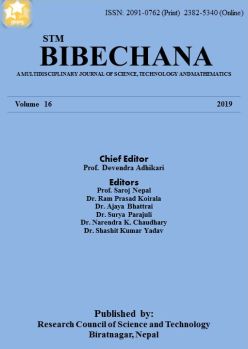Structural and thermal characterization of different types of cellulosic fibers
DOI:
https://doi.org/10.3126/bibechana.v16i0.21650Keywords:
Natural fibers, Morphology, Electron microscopy, FTIR spectroscopy, CelluloseAbstract
Micro- and nanocrystalline cellulose were extracted from wheat stalk (WS) using different thermomechanical and chemical treatments and characterized by spectroscopic, microscopic and diffraction techniques. The virgin WS fibers were found to be structurally quite similar to the commercial microcrystalline cellulose (MCC). Similar to the commercial one, the MCC extracted from the WS possessed intense infrared (IR) peaks whereas those peaks became more broader in the nanocrystalline cellulose (NCC) of the same origin, which can be attributed to possible breakdown of inter- and intramolecular H-bonding due to strong acid treatment of the MCC. Microscopic results revealed characteristic textures of the MCC and the NCC, the MCC being irregular bundles of the primary crystals bound together with the amorphous phase. The latter was found to disintegrate upon acid hydrolysis giving rise to the rod-shaped nanocrystals having much larger surface area and thus possessing more intense hydrophilic character. The MCC was found to be more stable than the NCC which can be attributed to the presence of protective and binding coating provided by the amorphous cellulosic matter.
BIBECHANA 16 (2019) 177-186
Downloads
Downloads
Published
How to Cite
Issue
Section
License
This license enables reusers to distribute, remix, adapt, and build upon the material in any medium or format for noncommercial purposes only, and only so long as attribution is given to the creator.




